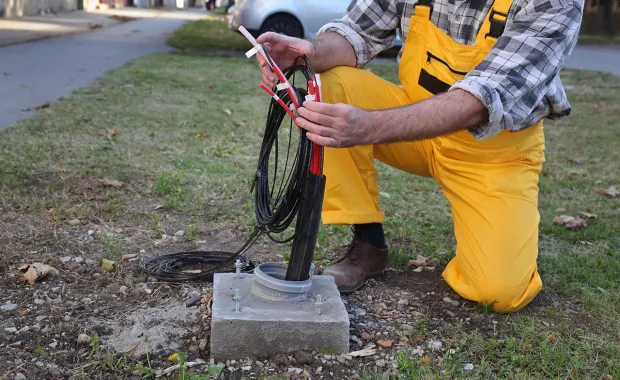Over the past few years, fixed UK telecoms players have shifted their investment strategy from the old copper network to much more flexible, reliable and capable fibre networks. Ofcom stated in the 2020 Connected Nations report that 5.1 million homes have access to full-fibre services, but this is only 18% of UK premises. On the other hand, the UK Government expects industry to reach 85% of premises by 2025, which is a lot of work to do over the next 4 years, with approximately 19 million premises still to be reached: an average of about 4.7 million premises a year.
The biggest telecoms players are investing billions of pounds in making this happen, and countless smaller local players are working hard to get fibre to their communities. But are they going as fast as they can?
Deploying fibre – not as easy as you think
You might think deploying fibre is easy – dig a trench and lay it in. In practice, doing this at scale is a bit trickier. You need to worry about issues like planning permission, wayleaves and remediation, as well as the skilled workforce needed to connect the fibre so it can deliver services. Often third parties do the physical digging and deployment and need to be integrated into the end-to-end process. It is critically important to keep good records of where you have put the fibre, so you know where customers are using it and can connect them efficiently where there is spare capacity. This may seem obvious, but it is not as easy to do as you might think.
Comprehensive planning is essential, as well as being confident that you are deploying to the areas that will deliver a good return on investment. There are often penalties for digging up roads multiple times, so it is important to get this right first time, ideally co-ordinating with other utilities to minimise disruption. As we know, it can be very costly to go back and fix problems later. There is of course no cash coming in until you enrol a paying customer, via a retail provider, to use the fibre, so getting the ordering process as slick as possible is critically important to cash flow.
Reliance on accurate data
The whole planning, deployment and order processes are supported data held in legacy systems. These will typically include a mix of inventory systems, planning systems and order management systems. Often this is where things start to crumble, as the systems do not always hold accurate data. Poor data quality is the result of poor processes; years of not recording assets accurately leads to inaccurate records. Unless data accuracy and record keeping is embedded into the process, and supported by the tools, then it cannot be relied on.
For example, ducts and cabinets might not be as recorded. Ducts may be fully utilised even when the system says there is space, leading to additional civil engineering work which can only be planned after a site visit uncovers the problem. If these re-works are not recorded, the inventory will remain inaccurate. Visual evidence is very helpful, recording the actual connection point showing newly installed fibres will be of use to the subsequent connection team. These visual images should be stored in the master inventory as a permanent record, to aid subsequent field work.
Getting the fibre built is only the first part of the challenge, the next step is to connect customers.
Installation issues might come up at the point of service installation. The order is built to use assets recorded in the inventory, but if this is inaccurate, the installer may not be able to find the allocated fibre or connection point, which leads to additional time being spent on the installation as they track down the correct equipment. In the worst case, yet more civil engineering work may be needed to provide additional fibres. This can be avoided if the inventory can be assured as being an accurate representation of the equipment actually deployed in the field. Visual records of the installed plan can help the technician carrying out connection work.
Getting the process right and the inventory data accurate, including visual imagery of physical endpoints as-built, can deliver significant benefits in both capital and operational expenditure, but there are no silver bullets. It takes industry knowledge, deep technical understanding, and a passion for doing things the right way. The on-site technicians need to understand the value of accuracy and be incentivised accordingly. The job is only complete when the inventory has been updated to reflect reality of what has been installed.
Optimising the process
Understanding the full end to end processes and data flows embedded in them is the first step. This will help you know where things are going wrong, and where the processes and data flows are weakest. Getting the process right should be the first step, the systems should support the process, not vice versa.
You then need people with the right mix of operational and technical skills to work through the process hot-spots and identify solutions. Working with teams who have solved similar problems can accelerate the learning, and enable you to solve the data challenges that are holding you and your customers back. Often small changes can make huge differences.
Deploying the right tools
Once you know how to optimise the processes, it is time to take a step back and look at the tools you have. Are the legacy systems going to be good enough to support the processes? Will they enable you to deliver against the business challenges you face? If not, then how do you develop a roadmap towards modernising the systems that enables you to deliver incremental value while swapping out the underlying systems, and keeping the solution affordable? The right approach is often to add new tools alongside existing core inventory. This will usually be much more cost-effective than a “rip and replace” strategy, assuming the data in the core system can be cleansed sufficiently to be reliable.
It is only when you have complete confidence that the inventory held in your systems of record reflect the real world that you can be sure in delivering right first time connections to your customers.
Working with partners
It takes partnership and perseverance, working alongside the operational teams, to identify specific solutions to the hot-spots in the processes and systems and get the data right. For example, capturing as-built installs on mobile devices can provide vital information for quality control and assurance that the contractor has completed the build to the right standards, and can speed resolution of problems when rework is needed. Legacy systems of record can work alongside more modern inventory systems to provide an end-to-end view of the installation.
Partners can bring fresh insight and new technology options, working with you to create a roadmap that delivers capability in the timescales you need, within your budget constraints.
To find out more about CGI’s Fibre Planning capabilities for Telecoms, download the brochure.
Find out more about CGI’s expertise in Communications and get in touch.






